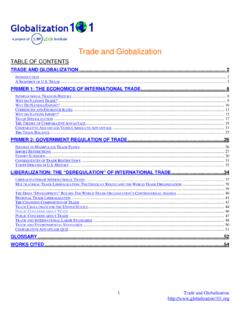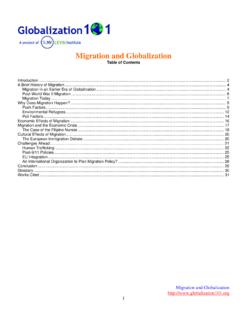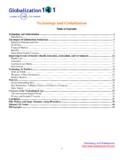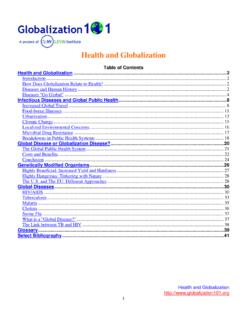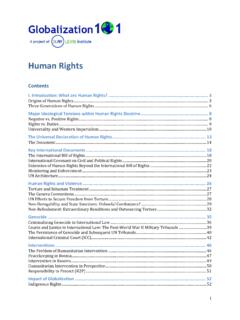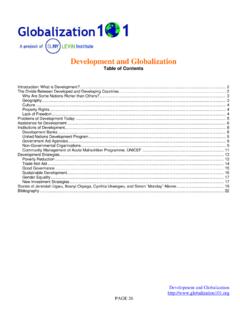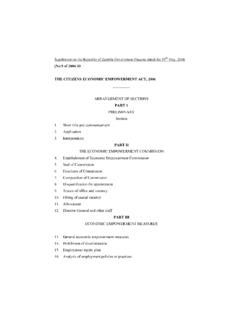Transcription of International Law and Organizations - …
1 International Law and Organizations 1 International Law and Organizations Table of Contents INTRODUCTION .. 2 WHAT IS International LAW?.. 3 IS International LAW REALLY LAW ? .. 3 WHAT ARE THE SOURCES OF International LAW? .. 3 HOW IS International LAW ENFORCED? .. 4 THE ISSUE OF SOVEREIGNTY .. 6 WHAT DOES International LAW ADDRESS? .. 7 LAW OF ARMED CONFLICT .. 7 International ECONOMIC LAW .. 7 International HUMAN RIGHTS LAW .. 8 International ENVIRONMENTAL LAW .. 8 WHO ARE THE VARIOUS ACTORS IN International LAW? .. 8 STATES .. 9 International Organizations .. 9 NON-GOVERNMENTAL Organizations .. 9 INDIVIDUALS .. 10 TRANSNATIONAL 10 International Organizations .
2 11 THE UNITED NATIONS SYSTEM .. 11 UN SPECIALIZED AGENCIES .. 12 UN RELATED Organizations .. 12 UN PROGRAMS AND FUNDS .. 13 REGIONAL Organizations .. 14 CONCLUSION .. 14 BIBLIOGRAPHY .. 16 International Law and Organizations 2 International Law and Organizations Introduction A vast network of International law and dozens of International Organizations make globalization possible. Treaties and other types of agreements among countries set rules for International trade and finance, such as the GATT; foster cooperation on protecting the environment, such as the Kyoto Protocol; and establish basic human rights, such as the International Covenant on Civil and Political Rights.
3 Meanwhile, among many International Organizations , the United Nations facilitates International diplomacy, the World Health organization coordinates International public health and protection, and the International Labor organization monitors and fosters workers rights around the world. The scope and authority of International law have thus expanded dramatically during the era of globalization. Historically, International law addressed only relations between states in certain limited areas (such as war and diplomacy) and was dependent on the sovereignty and territorial boundaries of distinct countries (generally referred to as states ).
4 But globalization has changed International law in numerous ways. For example, as globalization has accelerated, International law has become a vehicle for states to cooperate regarding new areas of International relations (such as the environment and human rights), many of them requiring states to rethink the previous notions of the inviolable sovereign state. The continued growth of International law is even more remarkable in this sense, since states, having undoubtedly weighed the costs and benefits of the loss of this valuable sovereignty, have still chosen to continue the growth of International law. Because of the need for enhanced International (or as some call it, transnational ) cooperation, globalization has therefore given new meanings to classic issues.
5 Questions of the authority of a country within its own borders that is, its state sovereignty the role of the individual in the International community of nation-states, and the authority of International Organizations , have all evolved in light of the forces of globalization. The following Issue in Depth describes the sources of International law and the subjects it covers; the International Organizations that implement International law; and some of the controversial aspects related to International law and Organizations as well as their relationships to state sovereignty. International Law and Organizations 3 What Is International Law?
6 Basically defined, International law is simply the set of rules that countries follow in dealing with each other. There are three distinct legal processes that can be indentified in International Law that include Public International Law (The relationship between sovereign states and International entities such as International Criminal Court), Private International Law (Addressing questions of jurisdiction in conflict), and Supranational Law (The set of collective laws that sovereign states voluntarily yield to). But this basic definition must be supplemented with three more-complex explanations is International law really law, the way the laws of the United States, enforced by courts and police, are?
7 Where do we find the rules of International law? Are they written down somewhere? Finally, how is International law enforced, if there is no world government? Is International Law Really Law ? There are several ways to think about law. In the domestic legal system, we think of law as the rules that the government issues to control the lives of its citizens. Those rules are generally created by the legislature, interpreted by the judiciary, and enforced by the executive branch, using the police, if necessary, to force citizens to obey. What is law for the International community if there is no one legislature, judiciary, executive branch, or police force?
8 Imagine a school playground with several children at play. The law is the set of playground rules that the teacher tells her students. For example, she might tell them, Don t hit your classmate. Two different reasons can explain why the children will follow this rule. On the one hand, they may follow the rule only because they are afraid of being punished by the teacher. On the other hand, the students may believe that it is a bad thing to hit their classmates. Since it is a bad thing to do, they will follow the teacher s rule. In the first case, they will obey the rule only if the teacher is there and ready to punish them. In the second case, students will obey the rule even if the teacher is not there.
9 In fact, even if the teacher is not present, the children may obey the rule because they have become used to not hitting each other and have therefore enjoyed playing with each other. Just as certain common understandings between children may make it easier for them to play, collective agreement on certain rules can often serve the interests of all the members of a community. Just as on a playground without a teacher, in the International setting there is no central authority. For the most part, however, states will follow the rules they have agreed to follow because it makes these interactions easier for all parties involved. Thus, the fact that there is no overall authority to force compliance with the rules does not necessarily mean that there is no law.
10 Law still exists in this setting, though it may be practiced and enforced in different ways. International law can therefore be called real law, but with different characteristics from the law practiced in domestic settings, where there is a legislature, judiciary, executive, and police force. What Are the Sources of International Law? Since there is no world government, there is no world Congress or parliament to make International law the way domestic legislatures create laws for one country. As such, there can be significant difficulty in establishing exactly what International law is. Various sources, however principally treaties between states are considered authoritative statements of International law.
